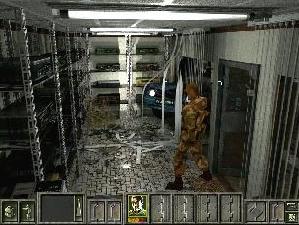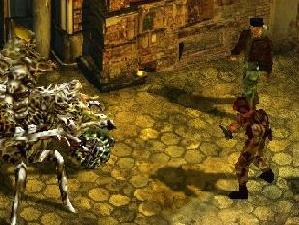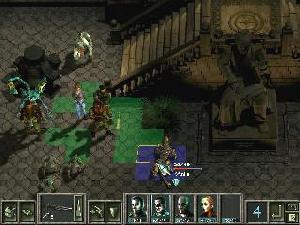Have you heard the one about the Polish guy and the bio-mechanical monster?
The place? Poland. The time? The present. The mission? Discover why an entire
Polish town fell silent. Secondary mission? Discover what happened to the first
team that was sent in. Accomplish your mission or the town will be ground zero
of a nuclear explosion. If you can’t explain it . . . destroy it.
Upon landing
on the shore, your small team quickly encounters some thing blocking their
path. The beast seems neither human nor animal, neither mechanical nor biological.
It attacks, but falls under a barrage of bullets. You realize something horrible
has happened. Even if you get out of this situation alive, these creatures will
forever haunt your nightmares. The hatred you feel for these abominations is immense.
You feel driven to find out who made these monsters, what became of the people
of the city, and who the real enemy is.
Horror games seem to get more and more popular every year. With high profile
console games like the Resident Evil
series, it’s little wonder. Monolith’s Odium falls neatly into the horror
setting and shows us why horror in computer games amounts to more than most
horror movies (ie. it’s not enough to just have a killer run around “knowing
what you did last summer”). Besides having a good horror plot, Odium
defies description with it’s cross-genre style of gameplay. While this game
might not have the marketing bang or the big money that other titles might have,
it’s an example of what a good, solid game should be.
Since the gameplay is the most unique part of the game, let’s start there.
Odium can best be described as an adventure/strategy/RPG. While many times
a blending of genres can lead to problems, the fusing of gameplay in this instance
just leads to a great game.
Adventure-wise, Odium is fairly standard. Find an item, use it somewhere else to solve a puzzle or to get another item . . . nothing really new here. You are in adventure mode for most of the time you play Odium. However, this all changes when you enter combat.
Once combat is initiated, the game becomes turn-based strategy, reminiscent
of the X-Com series. Each of the characters you control can move a specified
amount and initiate one action each turn (ie use medkit, attack the enemy, defend).
Once your turn is completed, the enemy moves. Much like chess, you have to think
out your moves ahead of time, so your characters don’t get dismembered.
All the while, the RPG elements are in effect. Your characters gain experience
and go up levels much like any RPG that you’ve played before. Also, the characters
get better with the weapons they use the most. For example, your character might
be level 3, but he might have a level 5 efficiency in rifles because you always
have him use a rifle. On the other hand, he might have a level 1 efficiency in
using a baseball bat. This setup allows for your characters to become highly specialized
as the game progresses.
 The progression
The progression
of the game is another element that makes this game stand out. Though there is
a definite plot line, it’s remarkably non-linear. So, while you do encounter the
door that requires a handprint identification to progress, you might find two
or three other areas to go to instead. The game focuses more on exploration and
story development rather than just going from point A to point B.
The graphics in Odium are decent, but they also don’t require an uber-computer
in order to run. All the backgrounds are flat images, not rendered, similar to
the Resident Evil series. The characters themselves are polygonal, but
they seem to interact with the surroundings very well. If you have a 3D card,
it will allow you to zoom in on the action, other than that it’ll look exactly
the same.
All the instances of combat in Odium appear to be pre-scripted. Unlike
many RPG games which feature random encounters, Odium has the creatures
lay in wait, attacking you in force when you walk into their traps. When combat
begins, you fight in a larger version of the exact same area that you were walking
around in rather than a generic arena. While some gamers may be upset by the lack
of constant action, pre-scripted battles allowed the designers to involve background
interaction as a strategy in the game (ie blowing up gas barrels to kill enemies
rather than shooting them directly). Also, this setup allowed the designers to
fit plot progression into the battles, having many battles start or end with audio
events.
The control is all mouse-driven, which is both good and bad. It’s good because every action is just a few clicks away. It’s bad if you have to repeat those few clicks a bunch of times in a row.
The complaints about Odium are fairly minor, but they’re still noticeable.
First off, the game is hard. From the first moment, you’re confronted with a lot
of beasties. Save often, because death can come quickly. Secondly, you can’t skip
audio events. While that’s great because you can’t skip an important event by
mistake, if you die, going back through long audio events (with no pretty video)
can get a bit lame.
My final gripe has to do with the plot. You control three commandos entering
a quarantined city where the first team vanished. Don’t you think that you’d bring
more than 30 bullets per person? The US Army doesn’t even let soldiers out on
training missions without at least 100 rounds. They could’ve found a better way
to balance the difficulty instead of making ammo scarce.
Though the name of the game is Odium (n. hatred coupled with disgust),
it’s really hard to hate this game. Novel gameplay and an engrossing plot make
this game a joy to play. Fans of both RPG’s and Strategy games are in for a treat.
Now if only they could’ve thrown in a few zombies . . .

-
Great Plot
-
Novel Gameplay
-
Great Blend of Genres
-
Lack of Ammo











